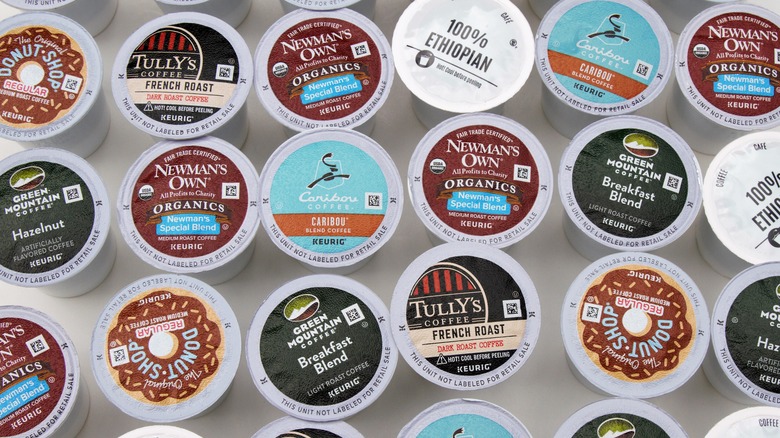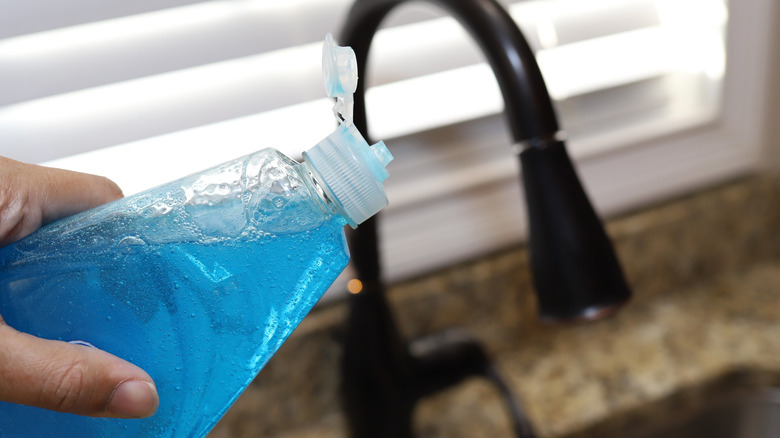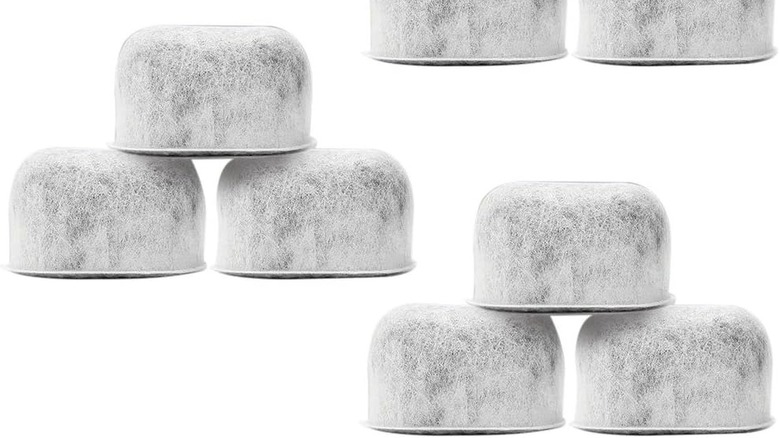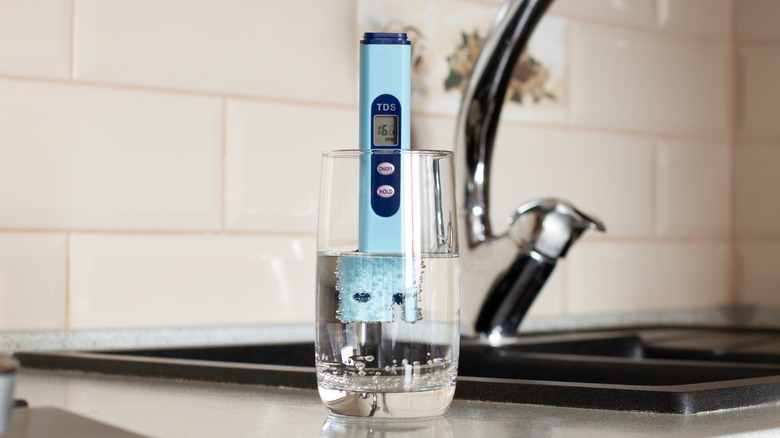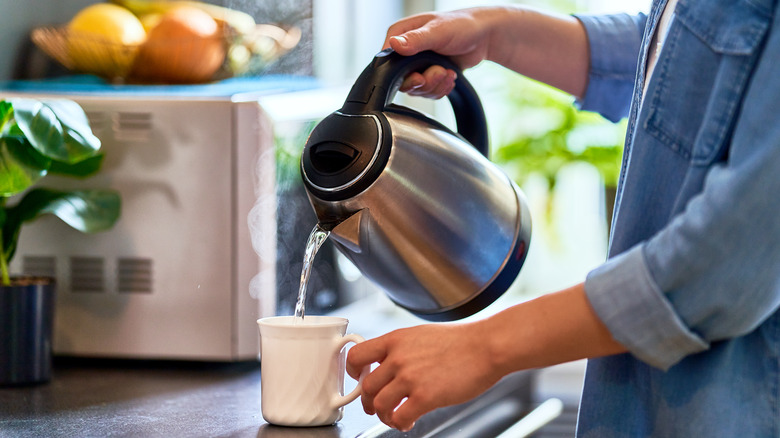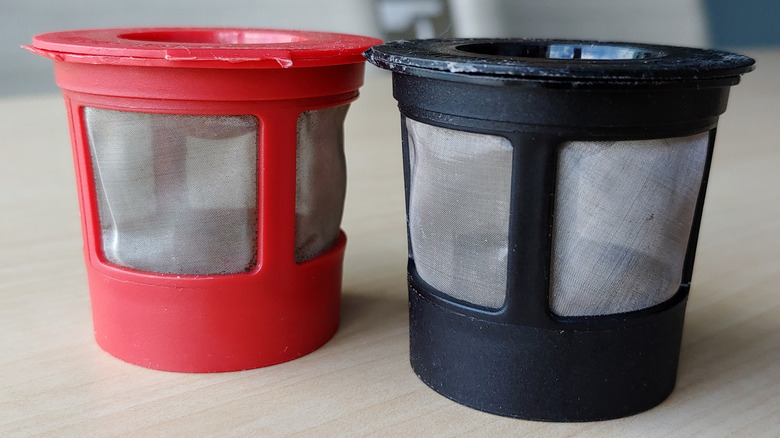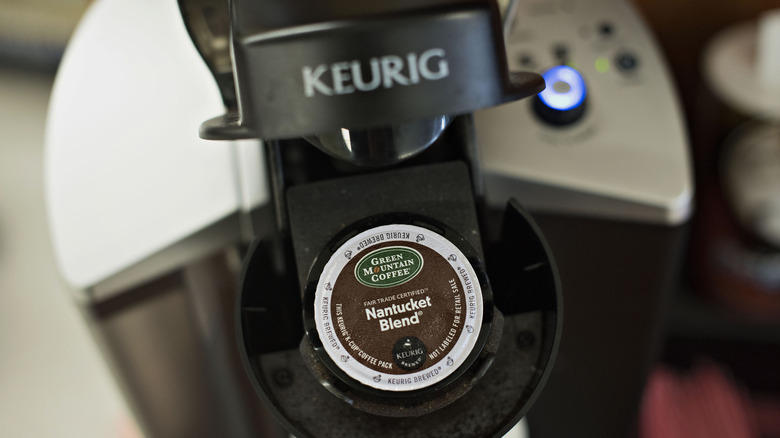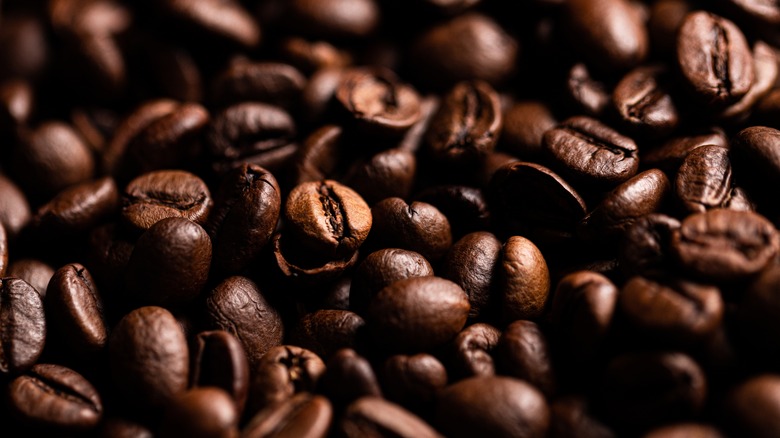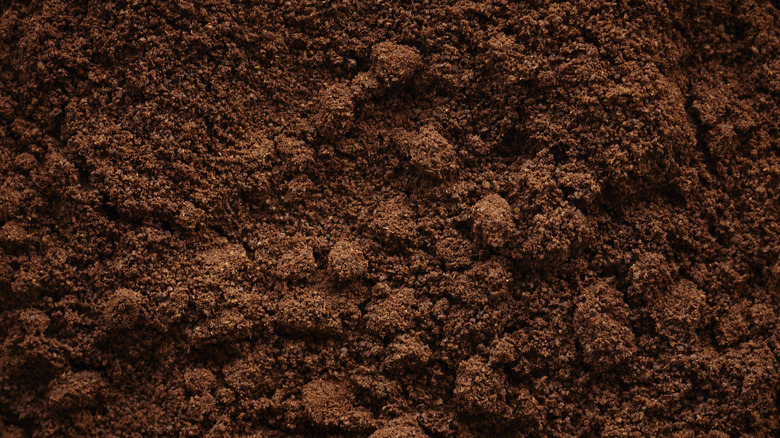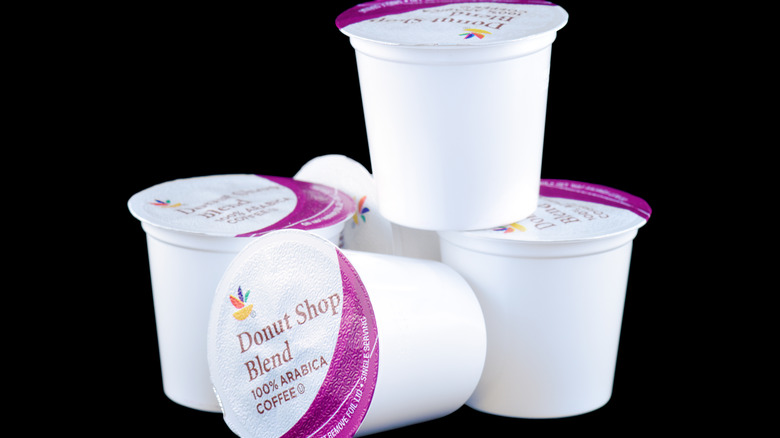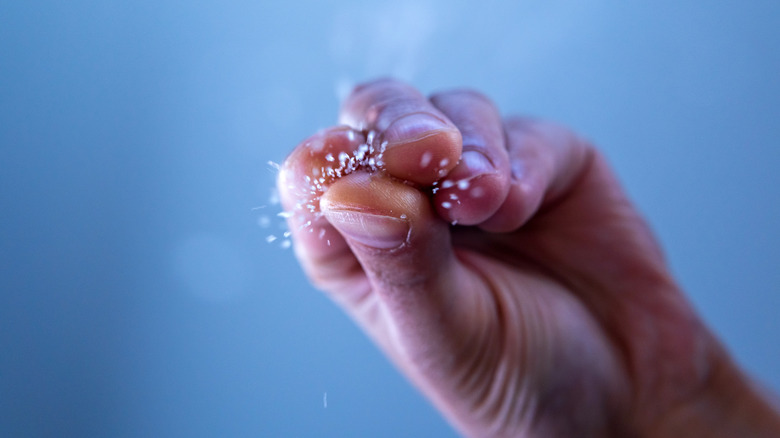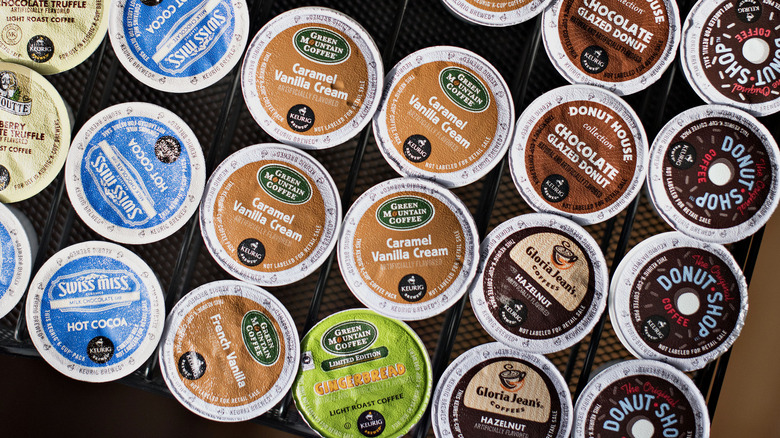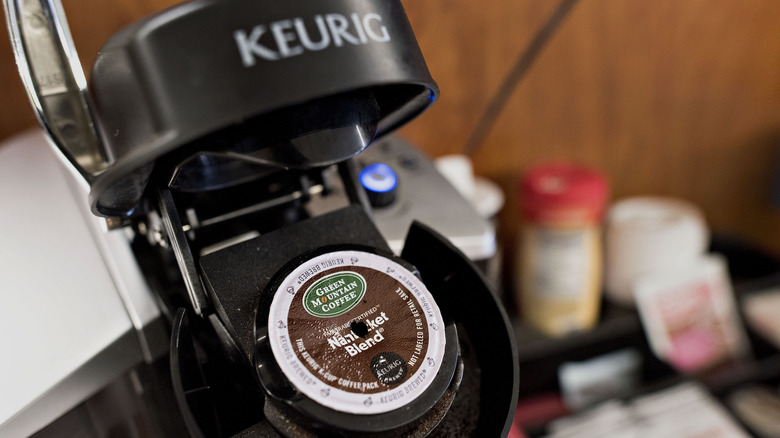12 Keurig Hacks To Get The Most Out Of Your Coffee Pods
We may receive a commission on purchases made from links.
Oh coffee, how we love thee. The bringer of mornings; the remedy for the midday lull; really though... what would life be without coffee? Roasted and rich, coffee's distinct aroma awakens the senses and its flavor warms the soul. It's an ancient beverage beloved worldwide for its energy-boosting abilities, delicious taste, and health benefits — in moderation, of course. According to Johns Hopkins Medicine, one to two cups of coffee a day will keep heart failure away, and that's just one of many reasons to love it.
But let's get back to the best part: taste. A quality cup of joe should have a nice balance of sweetness, bitterness, and acidity. For example, light roast coffees are known for having complex flavor profiles, whereas dark roast coffees are simpler and more concentrated. Between the flavor spectrum of light and dark roasts, there's a multitude of varieties to keep coffee lovers happily bouncing off the walls. After all, when you want your coffee, you want it now.
When it comes to instant coffee gratification, no brand keeps you more caffeinated and confident than Keurig. While not as fancy as a nitro cold brew, what Keurig cups lack in taste, they make up for in speed. So to help you enjoy a quality cup of joe and save time, here's a list of Keurig hacks to get the most out of those little pods.
It's important to keep a Keurig clean
Before going all caffeine crazy, it's important to make sure that a Keurig is clean. Single-serve coffee makers require routine maintenance. A clean Keurig protects from bacteria growth and also helps the inner workings run more smoothly. The inside and outside need to be sanitized thoroughly; before beginning, make sure it's unplugged from the wall socket, remove the water reservoir and pour out any remaining agua.
Next, wash the water reservoir and exterior with soapy water — ideally, clean the reservoir at least once a week. A toothbrush is great for getting into the crevices to remove coffee residue. Scrub the K-cup holder as well, then descale and remove build-up by running vinegar or citric acid through a brew cycle. Just make sure to rinse it out with hot water.
Another no-no is leaving water in the Keurig. A couple of days is fine, but emptying it out nightly is not only the safe move, but also smart because fresh water makes better-tasting coffee. No matter what, never brew with stale water that's been sitting for several days. It's an invitation for mold, bacteria, and even limescale.
Remember to replace the water filter
Proper maintenance makes the difference between a great-tasting cup of coffee and an okay one. So, one of the most important parts of the Keurig brewing process is the water filter. A clean filter provides a more enjoyable taste, while a dirty one ... well, your tastebuds deserve better. According to WikiHow, Keurig recommends that you replace your water filter every two months. Sidebar: There are some models that don't include a water filter.
For Keurigs with a water filter, follow these simple steps to make sure the coffee water stays as fresh as possible. Remove the lid to the water reservoir, followed by the water filter. Open the filter holder to dispose of the used filter. Before installing a fresh one, make sure to soak them in cold water for 5 to 10 minutes. They're ready when they've sunken to the bottom of the bowl.
Next, remove them from the bowl and rinse away any remaining charcoal bits with water for 60 seconds. After rinsing off the new filter, repeat the same with the lower filter holder. Now, put the filter into the holder and place it back into the Keurig. It's as easy as that.
Use better quality water
Quality water equals quality coffee, it's as simple as that. Not only is it important to make sure the filter is clean, but the type of water itself can impact the taste of coffee as well. Water acts as a solvent during the brewing process, helping the coffee grinds dissolve and infuse. To further explain the relationship between water and coffee, take a quick detour down Water Science Lane. According to the Coffee Chronicler, the minerals magnesium and calcium play the biggest role in extracting flavor from coffee beans.
Coffee researchers concluded that a 2:1 ratio between those two minerals and the level of the water's alkalinity is the key to a perfectly balanced and flavor-rich coffee. While all of that might sound complex, it's actually easier than you think. Rather than using tap water, try a Brita filter — you can even run the water through the filter twice before brewing with it. Quality bottled alkaline water is always a safe bet, but for true barista barons, there are pre-made mineral mixtures.
Along with low-quality water, another way people use their Keurig wrong is by not making sure the water is hot enough to brew efficiently. Run one to two brew cycles using only water. According to the National Coffee Association, the ideal is for the water to be between 195 degrees Fahrenheit and 205 degrees Fahrenheit.
Make sure to pre-heat the Keurig
In the pursuit of impressive-tasting coffee, all sorts of tips and tricks must be employed. Temperature is critical to the brewing process.
If using lukewarm water, most likely lukewarm results will follow. To reiterate, the ideal water temperature for brewing coffee ranges from 195 degrees Fahrenheit and 205 degrees Fahrenheit. It impacts the rate at which flavors and substances are extracted from the coffee beans. Hotter water extracts oils, acids, and caffeine at a higher rate than colder. Overheating can also lead to over-extraction and bitterness, while cooler temperatures might result in under-extraction and wateriness.
Cold brews are an exception, only because they're brewed longer to compensate for the lower temperature. To achieve a more flavorful cup, the same rules apply when using a Keurig. In contrast, according to Keurig, the temperature only reaches 192 degrees Fahrenheit. That's slightly lower than the minimum that the National Coffee Association recommends.
Why settle for less-than-spectacular coffee, though? Fortunately, there's an extra step before brewing that'll make up the difference: Warm up the cup. Before filling the water reservoir, pour hot water into the cup, or toss it in the microwave for a few seconds. This will boost the temperature level as it brews into the cup, resulting in more flavorful coffee.
Reusable filters help you avoid stale Keurig cups
Avoid a stale cup of joe with reusable K-cups. While the invention of K-cups revolutionized the concept of instant coffee, the brand's reusable version reinvented the wheel again. K-cups generally range in quality, with medium and dark roasts producing better overall results. Reusable cups allow coffee drinkers to enjoy any drink of choice, enjoying the time-saving powers of the Keurig without compromising on taste.
Keurig's Universal Reusable Filter was designed with MultiStream Technology, helping it extract optimal flavor. It's compatible with all Keurig home coffee makers. Along with coffee grounds, it's compatible with Keurig's countless K-cup options. Purchase the Universal Reusable Filter online for only $15.99 in a single pack; there are off-brand reusable filters that work with Keurig as well.
Use the small cup setting for more robust coffee
One good hack for brewing a more robust cup comes by adjusting the setting on a Keurig. Cup setting sizes vary, but typically stick to four size options: 4 oz., 6 oz., 8 oz., and 10 oz. There are models that offer 3-cup and 5-cup models too, amongst other larger sizes. It's natural to choose the setting based on the size of a mug, but the key to getting the most out of Keurig is actually counter-intuitive: Use the smallest-sized setting.
It makes a lot of sense. Using the larger-sized setting requires more water, which dilutes the strength of the coffee. All K-Cups contain the same amount of coffee grounds, so in other words, the larger-sized setting will use more water to brew the same amount of coffee. On the other hand, a smaller-sized setting brews more concentrated, flavorful coffee. The only caveat is that multiple pods will be required to fill the cup completely, but a few extra minutes are sometimes totally worth the wait.
Keurig works best with medium and dark roasts
Let's face it, the coffee a Keurig produces is a far cry from the premium options found at a cafe. But that doesn't mean it can't be improved.
A simple hack to more flavorful coffee is by sticking with medium and dark roasts only. According to Perfect Daily Grind, light roasts require longer brew times because they're less porous than darker varieties, which means that they extract compounds more slowly.
Since a Keurig brews coffee in under 5 minutes, there's simply not enough time to produce optimal flavor from light roasts. Medium and dark roasts typically take only between 3-5 minutes at the most. Wondering why Keurig coffee sometimes has that sour, earthy taste? Switch to medium or dark roast; there are countless K-cup options from which to choose.
Dunkin' might be one of the best K-Cup makers around — their Original Blend, in particular, is known for its strength and full-bodied flavor. Along with Dunkin', Starbucks' Pike Place blend is another popular option. Subtle and smooth, it comes super close to the real deal.
Swap a Keurig cup with your own coffee
With so many K-cup options to choose from, why go through the trouble of taste-testing when you can just use your favorite coffee? That way you can still save time, without making a sacrifice in the flavor department. You'll need a reusable Keurig filter for this next hack.
According to Keurig Canada, using their universal reusable filter only requires a few simple steps. Before you can begin your brew wizardry, you must first remove the universal filter from the machine, then detach the gray adapter from the pod — owners of Keurig 2.0 coffee makers must keep the adapter attached, though.
To open the filter, twist the top counterclockwise. There is a lock and unlock symbol that indicates whether it's open or closed. Next, remove the filter basket, set it down securely, and fill it to the "max" line with coffee grounds. Replace the filter basket inside of the holder and secure the lid clockwise. You can now install the filter inside the Keurig machine — make sure the white arrow on the lid is facing toward the rear of the Keurig. Lastly, lower the handle, select your desired cup size, and then activate the brewing process.
Try using two pods rather than one
A simple way to boost the robustness of coffee is by using more than one pod. As mentioned, roast type, cup size, and water temperature all impact the taste of Keurig-brewed coffee. Keurig's unpredictable quality surely inspired coffee connoisseurs to create fun hacks like these. After you've selected two medium or dark roast pods, adjusted your Keurig to the smallest-sized setting, and pre-heated your cup with hot water, you can start the first brew cycle.
The first pod on the smallest setting will produce super-concentrated coffee. Next, run a second cycle with another pod to fill the cup. In just a few more minutes, you can brew up strong, full-bodied coffee. If you've owned a Keurig for a while yet have never tried this hack, you'll be pleasantly surprised with the flavorful results. Not only will you enjoy better coffee using this hack, if your leftover K-cups start accumulating, you use Keurig's handy K-Cup recycling program.
Reduce acidity with a pinch of salt
Did you know that adding a little salt can improve the taste of your coffee? According to Perfect Grind Daily, salt helps balance bitter-leaning coffee and dark roasts. It brings out the natural sweetness in the grounds and intensifies its aroma. For those not into bitterness, add a pinch of salt. This hack doesn't only work for Keurig brews but for all coffee in general. Salt can also be used in place of milk and sugar for a touch of sweetness.
A study called Suppression of Bitterness by Sodium: Variation Among Bitter Taste Stimuli, which was published in Oxford Academic, found that sodium neutralizes bitterness. Even celebrity chef Alton Brown adds salt to his coffee. Brown says that, along with reducing bitterness, salt improves the stale taste of water that's been in storage. After bringing attention to the method, the hack was dubbed the "Alton Brown Trick."
When adding salt to coffee, it's important to be mindful of sodium intake. Consuming too much can cause high blood pressure, per the CDC Dietary Guidelines For Americans. Brown recommends using just a quarter teaspoon of salt for every six tablespoons of coffee grounds. It's a paltry amount for a more pleasurable drinking experience.
Try the K-cup hack out
Leave it to coffee enthusiasts to unearth this next trick. One clever way to hack a Keurig is by doubling up on the K-cups. Along with a reputation for making coffee quickly, when it comes to taste, Keurig can be notoriously mediocre. It's why folks should lean towards medium and dark roasts — and on occasion, employ a leftover K-cup.
Make sure to clean all the remaining coffee grounds from the leftover K-cup, and remove its tin-foil top, leaving essentially an empty white plastic cup. In order to double up the cups, remove the top lip of the empty one so it'll fit inside the Keurig holder. Once removed, place a reusable filter inside of the empty cup and fill it with coffee grounds. Then begin the brewing process.
This hack produces increased pressure by using the combined powers of the empty K-cup and the reusable filter, which are both perforated. As hot water flows and filters through the grounds, the output pressure refines and elevates the java.
Remove the K-Cup before the brew cycle ends
Another hack for making better joe is really outside the box: yank the K-cup during the brewing cycle. This is because, sometimes, leaving the K-cup in for the full duration of the brewing process can produce undesirable results. Towards the end of cycling, the coffee grounds in K-cups tend to become watery and bitter-tasting. Those liquid remnants are enough to ruin the flavor. Mastering the timing of this hack could potentially prevent such a catastrophe.
To better gauge when to remove a K-cup, keep a close watch; when the actual coffee finishes releasing and the bitter-tasting liquid begins, go in for the removal. Don't worry about making a mess, either, as Keurigs are equipped with a decent-sized reservoir to capture any liquids that keep dripping after the coffee is finished. A tainted-tasting beverage is the worst way to kick off a day, and this is a good way to prevent it.
